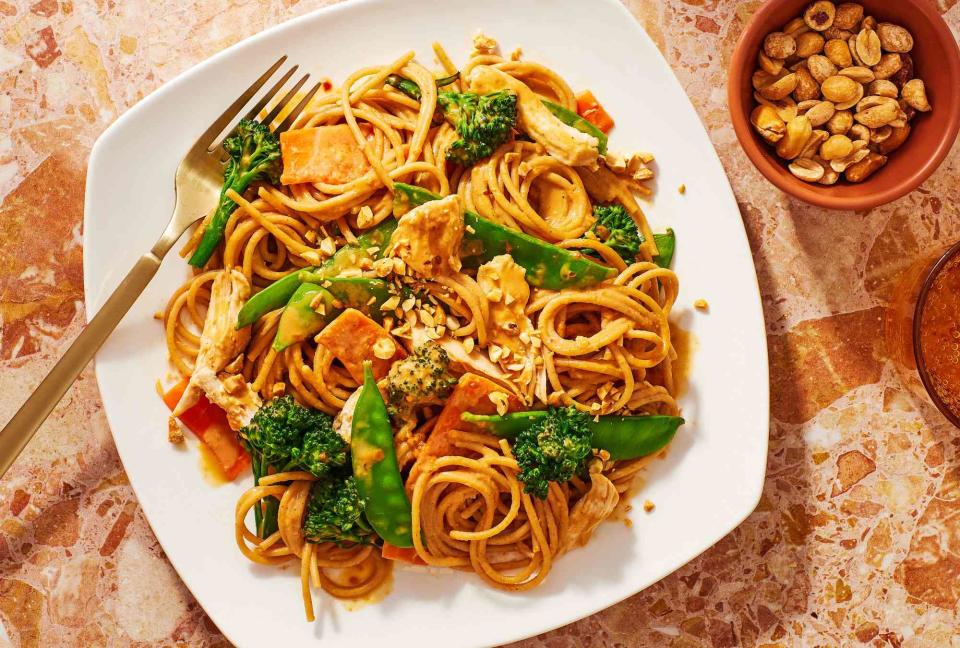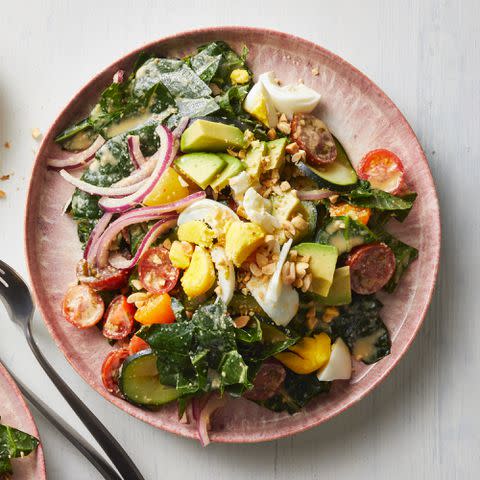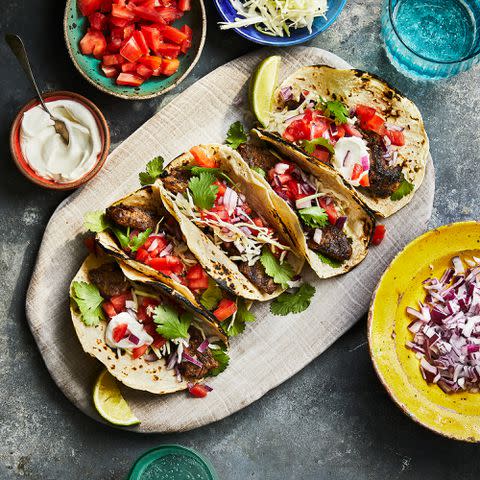The Surprising Ingredient You Should Be Eating on the Mediterranean Diet—Here's Why
From peanut butter to peanut oil, learn about all the delicious ways this healthy legume can be used in the kitchen.

Reviewed by Dietitian Maria Laura Haddad-Garcia
From PB&Js to peanut soup, peanuts and peanut products are staples in many American family meals. In 2021, the U.S. produced 6.4 billion pounds of peanuts for use in peanut butter, peanut oil and more. The legume is a powerhouse in the kitchen, praised for both its culinary versatility and nutritional value, and is used in cuisines across the globe.
The Mediterranean diet—often touted as one of the healthiest eating patterns—encourages eating a variety of nuts and legumes. While peanuts may not be the first nut or legume you'd think of, they can absolutely fit into a Mediterranean diet eating pattern. Whether it's a soup from Bolivia or a stir-fry from China, here's why this healthy nut could be an essential ingredient in your diet (if you're incorporating peanuts into your diet, be mindful of those with peanut allergies and be cautious of consuming peanut products in public places).
Peanut Health Benefits & the Mediterranean Diet
Rather than having strict parameters (a common drawback of fad diets), the Mediterranean diet is a healthy eating pattern that focuses on increasing the intake of certain foods, like fruits, vegetables and whole grains, while limiting others, like red meat and foods with excess added sugar and sodium. One important food group that the diet focuses on is legumes, as they're a high-fiber source of lean protein and low in saturated fat (the kind of fat that can do harm when eaten in excess). Peanuts are a type of legume, though often thought of as a nut—another healthy food group that fits the Mediterranean diet eating pattern.
Peanuts pack a ton of nutritional benefits into their shell. According to the USDA, 1 ounce of raw (not roasted), no-salt-added peanuts contains:
Calories: 160
Total Carbohydrates: 5 g
Dietary Fiber: 2 g
Total Sugars: 1 g
Protein: 7 g
Total Fat: 14 g
Saturated Fat: 2 g
Sodium: 3 mg
Folate: 68 mcg
Magnesium: 49 mg
With their trifecta of fiber, protein and fat, snacking on peanuts may help you stay energized between meals. They're also a good source of important nutrients like folate and magnesium. According to the National Institutes of Health, a 1-ounce serving of peanuts provides 17% of the Daily Value for folate and 12% of the DV for magnesium. Research, such as a 2022 article in Future Foods, shows that peanuts may help reduce inflammation and lower cholesterol and blood pressure levels.
How to Cook with Peanuts
Whether you're using peanuts, peanut butter or peanut oil, there are so many delicious ways to incorporate this healthy ingredient in your cooking while following the Mediterranean diet. Here, we'll break down different dishes you can try from around the globe that highlight the different forms of peanuts in all their glory.
Peanuts

One delicious way to use peanuts is crushed in Salsa Macha. This Mexican condiment comes from the Veracruz region, and can be enjoyed in many tasty ways. It can be used as a dip for chips or stirred into stews. You can also try spooning it over fish, which is one of the key protein sources for those following the Mediterranean diet.
You can also incorporate peanuts by using them in a salad. In this Collard Green Salad with Peanut Vinaigrette (pictured above), peanuts do double duty. Unsalted roasted peanuts get blended with fish sauce, ginger and lime juice to create a tangy vinaigrette. Then, more peanuts get crushed to add a crunchy element on top of the salad. It's also a tasty way to enjoy several key food groups of the Mediterranean diet, including nuts, vegetables and healthy fats from avocado.
Peanuts are also highlighted in Kung Pao Tofu and Kung Pao Chicken with Bell Peppers. Both adapted versions of the classic Szechuan dish fit nicely into a Mediterranean diet eating pattern, due to the addition of lean protein (tofu or chicken, respectively), plenty of colorful vegetables and, when served over brown rice, fiber-rich whole grains. Peanuts are used as a crunchy garnish, while the plant-based dish also features peanut oil to sauté the tofu and peppers.
Peanut Butter

There are plenty of tasty ways to incorporate peanut butter into your diet. The pantry-friendly staple can be used as a spread on toast or incorporated into dressings, marinades and sauces. In Chicken Satay with Spicy Peanut Sauce, peanut butter is used to create a smooth sauce, perfect for dipping. Satay recipes across southeast Asia, including Indonesia, Singapore and Thailand, use peanut sauce to complement an array of grilled meats.
Related: How to Tell If Peanut Butter Is Bad
Another recipe that uses peanut butter is Quinoa Peanut Soup (Sopa de Mani). This take on a traditional Bolivian soup incorporates natural peanut butter. When stirred in at the end, peanut butter adds a nutty finish and deepens the flavor of the broth. This soup also features another key ingredient of the Mediterranean diet, whole grains. The quinoa and peanut butter both add a boost of protein to this healthy soup.
Peanut butter can also be used in sweet recipes. It's a great addition in desserts, from No-Bake Peanut Butter Cookies to Chocolate Peanut Butter Pie (pictured above). It can also be used in snacks, like Peanut Butter Energy Balls and Chocolate-Peanut Butter Energy Bars. Making your own desserts and snacks is a great way to control the amount of added sugar. Limiting the amount of sweets and processed foods in your diet is a key principle of the Mediterranean diet.
Peanut Oil

Peanut oil can be a healthy option when you're cooking. While its nutrition benefits differ from the whole food—peanuts are a great source of fiber and protein—a 1-tablespoon serving of peanut oil provides healthy unsaturated fats and is high in vitamin E. It has a high smoke point, about 450°F, so it's many cooks' go-to choice for deep-frying and stir-frying. For example, you could use it in Ebi Yakisoba (Stir-Fried Noodles with Shrimp & Vegetables) or in Vegan Pad Thai with Tofu.
The nutty oil can also be used as a flavoring, like in Beef Suya Tacos (pictured above). Suya, which has roots in Nigeria, is a grilled skewer of meat. While the Mediterranean diet suggests limiting your red meat intake, you can still enjoy it in moderation. The flexibility in the diet's parameters is one of the reasons for its continued popularity and long-term sustainability.
The Bottom Line
Peanuts are a delicious and healthy ingredient; they fit the principles of the Mediterranean diet and are well worth adding to your meals. Their satiating combination of protein, fiber and fats can help you stay full for longer periods of time. From salsas to desserts, there are numerous dishes you can make with peanuts, making it easy for you to incorporate Mediterranean diet principles with your current eating habits and cultural preferences.

